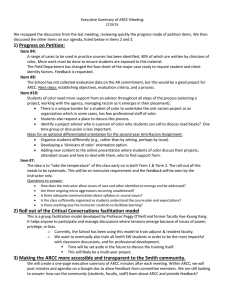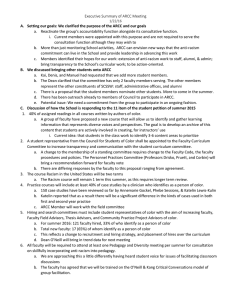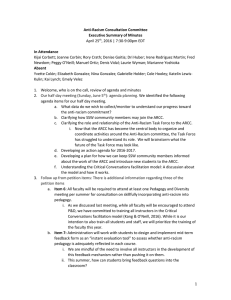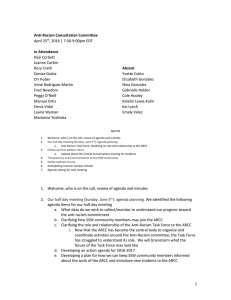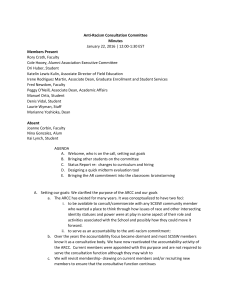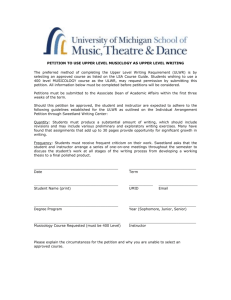ARCC Minutes 2/19/16 Vidal, Denis, Student
advertisement
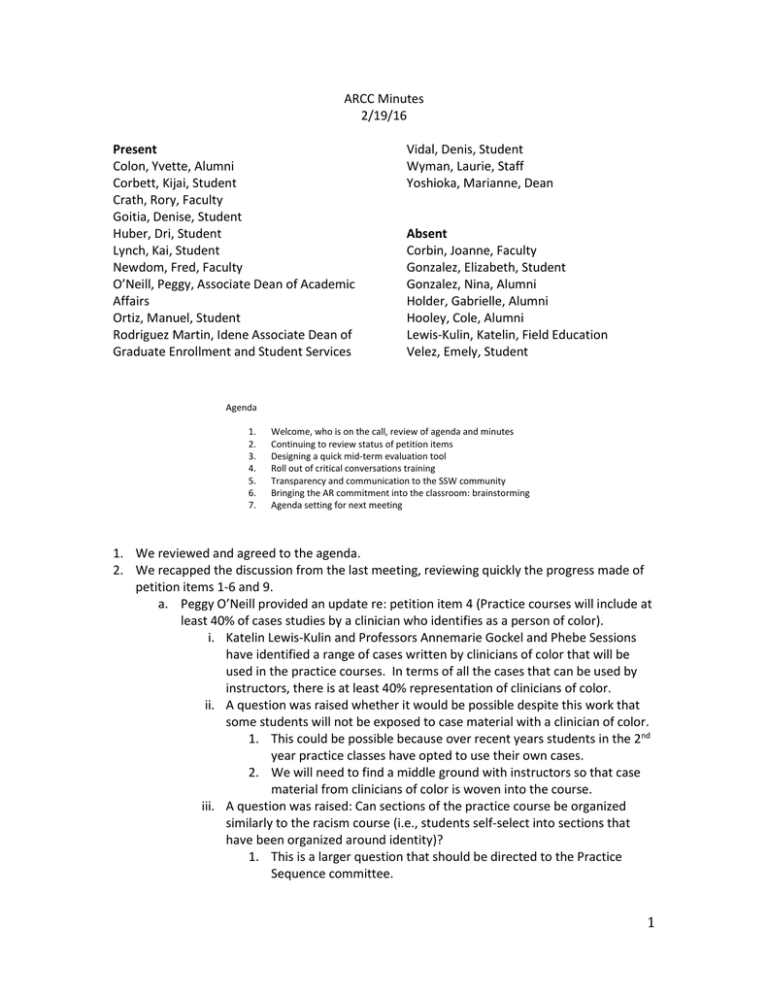
ARCC Minutes 2/19/16 Present Colon, Yvette, Alumni Corbett, Kijai, Student Crath, Rory, Faculty Goitia, Denise, Student Huber, Dri, Student Lynch, Kai, Student Newdom, Fred, Faculty O’Neill, Peggy, Associate Dean of Academic Affairs Ortiz, Manuel, Student Rodriguez Martin, Idene Associate Dean of Graduate Enrollment and Student Services Vidal, Denis, Student Wyman, Laurie, Staff Yoshioka, Marianne, Dean Absent Corbin, Joanne, Faculty Gonzalez, Elizabeth, Student Gonzalez, Nina, Alumni Holder, Gabrielle, Alumni Hooley, Cole, Alumni Lewis-Kulin, Katelin, Field Education Velez, Emely, Student Agenda 1. 2. 3. 4. 5. 6. 7. Welcome, who is on the call, review of agenda and minutes Continuing to review status of petition items Designing a quick mid-term evaluation tool Roll out of critical conversations training Transparency and communication to the SSW community Bringing the AR commitment into the classroom: brainstorming Agenda setting for next meeting 1. We reviewed and agreed to the agenda. 2. We recapped the discussion from the last meeting, reviewing quickly the progress made of petition items 1-6 and 9. a. Peggy O’Neill provided an update re: petition item 4 (Practice courses will include at least 40% of cases studies by a clinician who identifies as a person of color). i. Katelin Lewis-Kulin and Professors Annemarie Gockel and Phebe Sessions have identified a range of cases written by clinicians of color that will be used in the practice courses. In terms of all the cases that can be used by instructors, there is at least 40% representation of clinicians of color. ii. A question was raised whether it would be possible despite this work that some students will not be exposed to case material with a clinician of color. 1. This could be possible because over recent years students in the 2nd year practice classes have opted to use their own cases. 2. We will need to find a middle ground with instructors so that case material from clinicians of color is woven into the course. iii. A question was raised: Can sections of the practice course be organized similarly to the racism course (i.e., students self-select into sections that have been organized around identity)? 1. This is a larger question that should be directed to the Practice Sequence committee. 1 iv. Related to this, the Field Department has changed the face sheet of the major case study to require student and client identity factors. This will allow us to more easily identify the social locations of the individuals in the case. 1. Also the student is now asked on the face sheet whether they consent to allow the School to use their case material for educational purposes. v. The Field Department is seeking feedback on the new face sheet. b. Petition Item 8: Students will have access to qualitative and quantitative information from all evaluations of Smith’s Anti-Racism Commitment, including findings from course evaluation data on anti-racism. i. The School has not collected evaluation data on the AR commitment. We have monitored stats but have not tried to assess our progress. 1. We agreed that this is a good project for ARCC: establishing objectives, evaluation criteria and a process. 2. We have 2 items on course evaluations addressing some aspects of anti-racism, one related to the instructor and one related to course content. 3. From the theses that evaluated aspects of the anti-racism commitment and its impact, we identified some variables we should track. c. Petition Item 10: Students of color will be offered additional consultation from faculty of color and an optional differentiated orientation for the second year AntiRacism Assignment. i. The issue raised is that there is a unique burden for a student of color to undertake the anti-racism project at an organization which in some cases, has few professional staff of color. 1. Students of color need more support from an advisor in terms of selecting a project, addressing reactions by agency staff to their project and the ways they are then perceived after raising the topic, how to manage racism as it emerges from co-workers in the face of the project. 2. Given the emotional involvement for students of color related to implementing on a project like this, students are requesting a place to discuss the process. ii. Currently the in-person orientation to the AR assignment organizes students around settings. Students also must complete an online orientation which involves watching a video presentation by 3-5 students talking about the assignments they completed. Students have the option of completing a joint project. Ideas generated included: 1. Organize students differently (e.g., rather than be setting, perhaps by issue). 2. Developing a ‘clinicians of color’ orientation option. 3. Adding new content to the online presentation where students of color discuss their projects, attendant issues and how to deal with them, who to reach out to when they come up 2 4. Identify a project advisor who is a person of color who students can call to discuss road blocks? One time group or discussion is less important d. The admin reps on ARCC will discuss with the Field Education Department and bring an update to our next meeting 3. Petition item 7: Administration will work with students to design and implementation midtem feedback form as an “instant evaluation tool” to assess whether anti-racism pedagogy is adequately reflected in each course. a. The idea is to “take the temperature” of the class early on in both Term 1 and Term 2. i. How does the instructor allow issues of race and other identities to emerge and be addressed? ii. Are there ongoing micro aggressions occurring unaddressed? iii. Is there adequate communication about syllabus or course issues? iv. Is the class sufficiently organized so students understand the course plan and expectations? v. Is there anything else the instructor could do to facilitate learning? b. The roll out needs to be systematic, some faculty will be concerned about who else can see the feedback. Course Coordinators and Chairs will need to agree c. This will be an instructor requirement and the feedback will be seen by the instructor only. 4. Roll out of the Critical Conversations facilitation model: Can we train all the students in a train the trainer model a. Professors Peggy O’Neill and former Smith faculty Hye-Kyung Kang developed a group facilitation model, Critical Conversations, to help anyone – including instructors- to participate and manage discussions where tensions emerge because of issues of power, privilege, or bias. b. The School has moved toward training all resident and adjunct faculty and staff on this model. We currently have trained 72 adjunct faculty and almost all of the resident faculty. Follow up trainings and support are being planned. c. We want to move to a point where we also train all Smith students to be the most impactful with classroom discussions and for professional development. i. Could this constitute a students 2nd year AR project? d. We agreed to set aside some concentrated time to discuss the training itself. It was recognized that the training will be experienced differently for students than faculty. e. Professors O’Neill and Kang anticipate that the model will evolve with use, so that there is room also to shape the model. f. This will likely be a multi- year project. 5. How to make the work of the ARCC more accessible and transparent to the Smith community. a. At minimum, we will create an executive summary of the ARCC minutes to increase the likelihood that they will be read. b. For the ARCC itself, we will post minutes and agendas on a google doc for committee members to add in feedback. c. We are looking for a way for students, faculty, staff to learn about ARCC and provide feedback. How can the community comment? Submitted: Marianne Yoshioka, PhD, MSW 3 4
